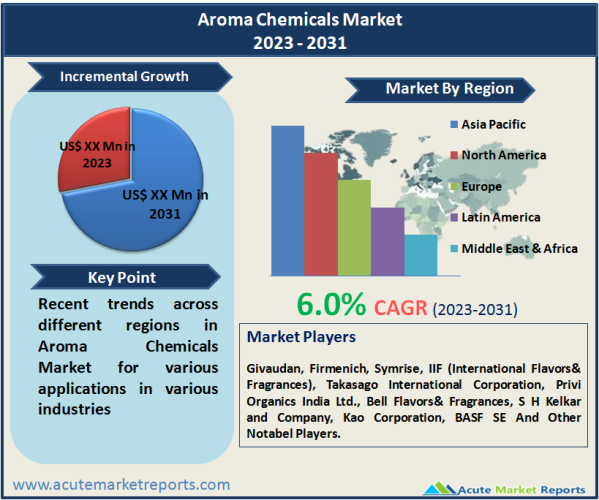
The aroma chemicals market serves as the hidden architect behind the scents that define our everyday experiences. Aroma chemicals, whether naturally derived or synthetically manufactured, are pivotal in creating the fragrances we encounter in perfumes, personal care products, household items, and even the foods we consume.Aroma chemicals are the unsung heroes of the fragrance industry, influencing scents in virtually every facet of modern life. These chemicals, whether obtained naturally from botanical sources or synthesized in laboratories, play a crucial role in crafting unique and memorable fragrances. Aroma chemicals marketis projected to grow at a CAGR of 6.0% from 2025 to 2033, driven by increasing consumer demand for fragrance across various applications.

Growing Demand for Personal Care and Household Products
A primary driver of the aroma chemicals market is the ever-increasing demand for personal care and household products. As consumers become more conscious of personal hygiene and grooming, the sales of perfumes, deodorants, shampoos, and other beauty and personal care items continue to rise. Household products such as detergents, air fresheners, and cleaning agents also rely on aroma chemicals to enhance their scents. This driver is substantiated by the consistent growth in the global personal care and household products industry, with consumers seeking pleasant and long-lasting fragrances in their daily products.
Expanding Food and Beverage Industry
The food and beverage industry represent another significant driver for the aroma chemicals market. Flavor is a crucial aspect of the consumer's dining experience, and aroma chemicals play a pivotal role in creating appealing and distinctive tastes. These chemicals are used to develop flavors for various food and beverage products, from candies to alcoholic beverages. The increasing demand for unique and diverse flavors, coupled with the global growth of the food and beverage industry, underlines the importance of aroma chemicals. Evidence of this driver can be seen in the extensive use of aroma chemicals by food and beverage manufacturers to cater to changing consumer preferences and launch innovative products.
Rising Awareness of Natural and Sustainable Products
The rising awareness among consumers regarding the benefits of natural and sustainable products is a significant driver in the aroma chemicals market. With increasing concerns about synthetic ingredients and environmental impact, there is a growing demand for natural and sustainably sourced aroma chemicals. Natural aroma chemicals, derived from botanical sources, offereco-friendlier and health-conscious alternative. The evidence for this driver is reflected in the shift toward natural and organic fragrances in the cosmetics and personal care industry, as well as the increased use of natural aroma chemicals in organic food and beverage products.
Regulatory Challenges and Quality Control
While the aroma chemicals market is thriving, it faces a substantial restraint in the form of regulatory challenges and the need for stringent quality control. Regulatory bodies worldwide impose strict regulations on the use of aroma chemicals in consumer products to ensure safety and consistency. Compliance with these regulations and maintaining product quality can be complex and costly for manufacturers. The evidence supporting this restraint can be observed in the rigorous testing and certification requirements that aroma chemical manufacturers must adhere to. Achieving and maintaining compliance can be a resource-intensive process that affects both production timelines and costs.
Synthetic Aroma Chemicals Dominates the Market by Type
Natural aroma chemicals are derived from botanical sources, such as essential oils and plant extracts, and are known for their authenticity and sustainability. Synthetic aroma chemicals, on the other hand, are manufactured through chemical processes and offer a wider range of customization options. In terms of market performance, both natural and synthetic aroma chemicals exhibit strong growth. While natural aroma chemicals are preferred in organic and natural product segments, synthetic aroma chemicals are valued for their versatility and cost-effectiveness. The "Synthetic" type of aroma chemicalsheld the highest revenue by type in the aroma chemicals market. Synthetic aroma chemicals are manufactured through chemical processes and are known for their versatility and cost-effectiveness. These chemicals find widespread use in various industries, including personal care, household products, and food and beverages, which contributes to their higher revenue generation compared to natural aroma chemicals.
Benzenoids Dominates the Market by Product
Aroma chemicals can be further categorized based on their chemical structure and characteristics. Terpenoids, found abundantly in nature, are known for their fresh and citrusy scents. Benzenoids encompass a wide range of fragrances, including floral and fruity notes. Musk chemicals provide a warm and sensual aroma. Other categories encompass a variety of unique scents that cater to specific product preferences. In terms of market performance, terpenoids have exhibited the highest compound annual growth rate (CAGR) due to their popularity in personal care and household products. Meanwhile, benzenoids lead in terms of revenue generation, owing to their widespread use in perfumes and fine fragrances.
Asia Pacific Remains as a Global Leader
The aroma chemicals market shows distinct geographic trends. North America and Europe have traditionally been key players in the market, with a high CAGR due to their well-established fragrance industries and consumer demand for high-quality scents. In terms of revenue percentage, Asia-Pacific dominates the market due to its vast population and increasing consumer spending on personal care and luxury products, particularly in emerging economies like China and India. These regions are expected to continue their growth trajectory in the coming years, with Africa also showing potential for significant adoption as consumer awareness of fragrances and personal care products rises.
Competitive Trends
The aroma chemicals market is characterized by intense competition among key players. Some of the leading companies operating in this space include Givaudan, Firmenich, Symrise, IIF (International Flavors& Fragrances), Takasago International Corporation, Privi Organics India Ltd., Bell Flavors& Fragrances, S H Kelkar and Company, Kao Corporation, and BASF SE. These companies employ various strategies, including research and development, acquisitions, and collaborations, to maintain a competitive edge. In 2024, these players reported substantial revenues, and in the expected forecast period from 2025 to 2033, they are anticipated to continue expanding their market presence by leveraging their global reach and innovative capabilities.
Historical & Forecast Period
This study report represents analysis of each segment from 2023 to 2033 considering 2024 as the base year. Compounded Annual Growth Rate (CAGR) for each of the respective segments estimated for the forecast period of 2025 to 2033.
The current report comprises of quantitative market estimations for each micro market for every geographical region and qualitative market analysis such as micro and macro environment analysis, market trends, competitive intelligence, segment analysis, porters five force model, top winning strategies, top investment markets, emerging trends and technological analysis, case studies, strategic conclusions and recommendations and other key market insights.
Research Methodology
The complete research study was conducted in three phases, namely: secondary research, primary research, and expert panel review. key data point that enables the estimation of Aroma Chemicals market are as follows:
Market forecast was performed through proprietary software that analyzes various qualitative and quantitative factors. Growth rate and CAGR were estimated through intensive secondary and primary research. Data triangulation across various data points provides accuracy across various analyzed market segments in the report. Application of both top down and bottom-up approach for validation of market estimation assures logical, methodical and mathematical consistency of the quantitative data.
| ATTRIBUTE | DETAILS |
|---|---|
| Research Period | 2023-2033 |
| Base Year | 2024 |
| Forecast Period | 2025-2033 |
| Historical Year | 2023 |
| Unit | USD Million |
| Segmentation | |
Type
| |
Product
| |
Application
| |
|
Region Segment (2023-2033; US$ Million)
|
Key questions answered in this report